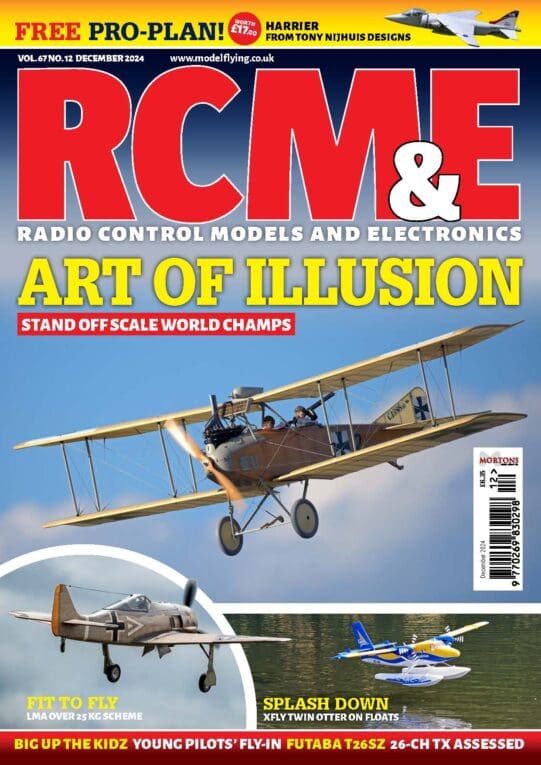Similar in appearance to Enya’s popular 41 four-stroke glow engine, this rather unusual hybrid is an interesting beast. Supplied partly assembled with cylinder head only lightly affixed, pushrod tubes loose in the box and rocker cover similarly detached, it’s clear that this one’s aimed at specialists and collectors who know one end of a conrod from the other. As we discussed in the last issue, the general construction is up to Enya’s impeccably high standard yet, as always, the proof of the pudding is in the eating. Stay tuned, then, as we seat ourselves for dinner and prepare to savour every mouthful of Enya’s brand new four-stroke diesel offering.
BENCH BOUND
Having fixed the 41 4CD to the bench, I searched the workshop for a length of neoprene tubing (silicone is useless for diesel) and a tank, with which to re-rig my test stand. The Enya’s spec sheet recommends propellers in the 12 – 14″ diameter and 5 – 8″ pitch range. To glow aficionados this may sound a bit on the large side for a 6.64cc engine but rest assured, these oil burners are known for their willingness in that department. I fitted a Bolly 13.5 x 8″ to begin with, its flywheel action being used to assist in starting the tight engine. Initially, the Enya would be run on a rich, half throttle mixture at low rpm. I should point out that this is the opposite way to go about things with a glow, where a smaller prop would be employed for early runs, particularly with an ABC set up.
Enjoy more RCM&E Magazine reading every month.
Click here to subscribe & save.
I was extremely sceptical when I first looked over the finer points of the 41 CD, confounded that there was no variable compression lever. Speaking with one very knowledgeable engine manufacturer who suggested that the engine couldn’t possibly work ‘properly’ did little to allay my suspicions. Every diesel I’ve owned has needed a judicious tweak on the tommy bar between hot and cold settings, and I expected the 41 CD to be reluctant to start and hard-running when warm because of it. In reality however, starting proved a total non-event, with but a single choked turn on the prop followed by a few leisurely swings to coax the engine into life. I put this partly down to a good piston seal and partly down to the fact that cylinder filling is more efficient than with a two -stroke (diesel or otherwise). Stopping and starting the 41 CD a few times to confirm that it really was as straightforward as it seemed, I set things a tad rich and put the engine through a few 5-minute runs. As the initial tightness at the top of the stroke mellowed the idle was reduced to an unbelievably slow 1200rpm, and the engine refused to stop until the fuel line was pulled off. Admittedly, top whack on the large 13.5 x 8″ prop was a lowly 5500rpm or so, and this blade was obviously at the upper limit for the engine, but I had great fun playing with plug washers, noting the effect and seeing how slow the engine would reliably idle over a prolonged period. With just the one head shim in place she was slightly over-compressed for the large prop, and some ‘diesel knock’ was evident on throttling-up.
Further runs followed, using Bolly 11.5 x 5″ and 12.5 x 6″ propellers. The 11.5 x 5″ rotated at well over 9000rpm and would be about the smallest practical working load for this engine. The specifications suggest 9000rpm as the upper limit for general use, and confirming that, a barely perceptible misfire with the needle set weak suggested a higher compression setting would be beneficial on smaller props. It’s clear that Enya have the engine more sorted than I gave them credit for, and to create a diesel four-stroke that runs from around 5000 to 9000rpm and idles at incredibly low speeds with complete reliability is quite an achievement, given that no compression adjustment is needed. I still think an adjustable chamber would vastly improve it though, making it far more flexible. Indeed, Enya could have achieved this with a simple adjustable plunger in the plug orifice, so I’m surprised they didn’t bother. I might make my own up to see if I’m onto anything here, but don’t get me wrong, this is no racing engine and it runs beautifully. I played around with it on the bench for three days, just for the enjoyment of its fuss-free starting and hearing the muted purring as it burbled away at modest speeds. One final conundrum… the CD is supplied with the much larger exhaust from the .53 four-stroke rather than the 41 4C, yet it’s quieter than either of them on an open exhaust… What’s that all about, then?
APPLAUSE PLEASE
To summarise, Enya are to be applauded for their decision to go ahead with this interesting engine, which doubtless arrived as a result of them taking a 41 4C glow engine and fiddling around to see if the concept could work. Well it does, and now you can buy one off the shelf. Mind you, it’s not cheap.




